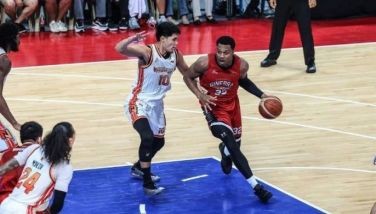The old days of basketball
For many purists, basketball was at its native best in the 1960’s and early 1970’s in the Philippines. Play was raw, free-flowing, and very rough. Back then, there were no pros, and amateurs were both players and employees of their mother companies. Of course, there was also very little regulation then. Most of the games never saw the light of television. You had to be there. Some would say the games were brutal, since there was really no formation, no technical training, just raw street ball transposed onto a wooden floor. The STAR spoke to several legends of Philippine basketball about those innocent, hardscrabble days, and how they survived, and why basketball was already our nation’s passion even back then.
“Many people are saying, why, why is that the sport that Filipinos like when we’re so lacking in height,” begins 1978 PBA Mythical Team member Danny Florencio. “Why is that our favorite? Maybe it’s because it’s easy to play. Just put a ring up in a post and you can play basketball, isn’t that so? Like when I started playing street basketball, because it’s easy to play.”
“It was always our national sport passion, probably not as much as today. Because economics came in, but ah, every, any street corner, I mean you would see a basketball court,” says former coach and deputy commissioner Tommy Manotoc. “Our own tennis court had a basketball goal on the side, you know. So it was a sport that ah, would get few people together and have a nice time.”
“And so teams were owned by corporation like the Crispa, Meralco, San Miguel etc. but players were considered as amateur and employees of the companies,” adds three-time PBA MVP Bogs Adornado. “Players were paid by salary and allowances with no written contracts, still a commercial league but considered as amateur.”
“My grandfather, Papa but he didn’t care at all you know he said, no this is what I want okay, whether it makes money or not I don’t care,” reveals Bones Floro, grandson of Crispa team owner Danny Floro. “We’re gonna have this basketball team we’re gonna make everybody happy we’re gonna make all the fans happy okay, it was not about business for him.”
“I got involved at that time in a very young age watching MICAA,” recalls San Mig Coffee head coach Tim Cone. “I met Bob Pressley, who was a 6-11 import for Meralco at that time. And so he gave us tickets to the games, ‘cause you know, Jaworski was on the team, Fernandez, Jimmy Mariano, Big Boy, I mean they got a great team, and we used to go to the practices in the Meralco Gym.”
And as always, any discussion about early Philippine basketball goes back to how physically demanding it was. If you didn’t come home bruised and aching, you weren’t really playing the game.
“Oh, it was terribly hard, especially for me, because I mostly played center,” explains PBA pioneer Manny Paner. “And I was guarding the big guys on the other teams, and they were 6’5”, like Ramon Fernandez and Abet Guidaben. I think I was the only 6’2” center during that time. It was more physical, more of rugged play. You’d really make each other’s body hurt back then.”
“Players would be more, aggressive, physically and ah, there were more people that, I would say they would put their body on you without thinking that you can get maimed, you can get injured,” says MICAA and PBA veteran Freddie Webb. “When you get injured, that would be to them a big factor, ‘cause you can’t play the next game. Or next time around you drive, you gotta think twice before getting into the painted area. So it’s a totally different ball game now. The truth is before, in the MICAA, when you fall trying to go for a lay-up, and people sometimes would even clap you know, compared to now. You know, people just liked dirty players. They just like the idea of you hurting your co-players. And I think among the players now, there is this rule that you know, this is our profession, you gotta make sure that we’re able to survive this.”
“You just have to be really creative, no,” insists four-time PBA MVP Mon Fernandez. “You have to watch the tapes, you have to watch your opponents, how they move, study there, their demeanor, how they react. You just have to keep on improving, finding new moves, so they would know what, what you’ll do.”
“During my time we didn’t have the training that the kids nowadays have,” remembers PBA pioneer Francis Arnaiz. “Now it’s all structured; they teach fundamentals you know from the clinics/We didn’t have any of that before, so I believe any talent one acquired was pretty much your own work ethic. I was so into it that I would constantly be on my own, in the gym, practicing.”
And even in the MICAA days, imports were already part of the landscape, so some players wound up sacrificial lambs, and had to guard the foreigners.
“Oh, it was super hard,” laughs Abe King. “You got the sort end of the stick, because 60 to 80 percent of the time, they had the ball. So you had to be really physically fit, you had to be really ready. You really had no room for mistakes because they could overpower you. They were well-built, and they were big because there were no height limits at the time. At the same time, many were former NBA players, and you could really see their statistics.”
Eventually, things became more professionalized and transparent. But for the legends of the game, those hardest of times were also the best of times, when they discovered, evolved, and led the way for all succeeding generations.
- Latest
- Trending





























